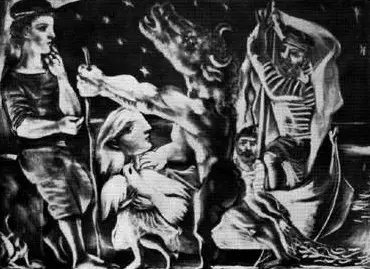The print, 97th out of a series of 100 commissioned by Ambroise Vollard, depicts a girl guiding a blinded minotaur through the night as three human figures look on. The minotaur makes several appearances throughout the Vollard Suite, named after the art dealer who ordered the etchings, and is believed to represent the shadow aspect of Picasso's unconscious. It was the minotaur's natural behaviour, after all, that caused King Minos to confine him within the Labyrinth.
Picasso, born in Málaga in 1881, began to explore themes from Classical mythology when he agreed to illustrate Albert Skira's 1931 edition of Ovid's Metamorphoses. Picasso's minotaur, as he appears in plate 27, is a traditional depiction of the mythological being in that he has the body of a man and the head of a bull. His powerful arms, rippling with muscle, are longer than his legs while his hands are larger than his feet. The minotaur, raising his head towards the sky, opens his mouth and protrudes his tongue in the manner of a beast crying out in anguish while clutching a stick in one hand and grasping the girl's shoulder in the other.
The girl, thought to represent Marie-Thérèse Walter, turns her head towards the minotaur as she leads him from the left-hand side of the portrait to the right. A dove, perched upon the girl's wrist, spreads one of its wings and parts its beak as it looks at the minotaur. Earlier prints featuring the minotaur, such as Baccic Scene With a Minotaur and Minotaur Kneeling Over Sleeping Girl, portray the mythological creature as a powerful being while the blind minotaur in this print is depicted in a vulnerable light. The towering, muscle-bound figure of the minotaur stands in stark contrast to the diminutive frame of the girl on whom he relies. This scene, witnessed by the boatmen and the youth by the tree, may allude to the artist's increasing dependence on his mistress during the final phases of their relationship.


